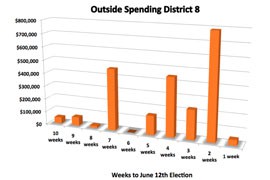Cronkite News has moved to a new home at cronkitenews.azpbs.org. Use this site to search archives from 2011 to May 2015. You can search the new site for current stories.
Outside groups poured money into last weeks of race to succeed Giffords
WASHINGTON – Outside groups poured more than $1 million into polling and advertising in the three weeks before the election to replace former Rep. Gabrielle Giffords, according to the Federal Election Commission.
National groups spent $517,570.06 in ads attacking Republican hopeful Jesse Kelly between May 24 and the special election on June 12, according to FEC reports filed last week.
They spent another $502,986.81 either supporting Kelly or attacking his rival, Democrat Ron Barber, who went on to win the special election.
The last-minute spending spree accounted for almost half of the more than $2.2 million in independent expenditures made by outside groups during the hotly contested special election.
Millions of dollars came into play because both sides saw it as an opportunity to turn the 8th District election into a referendum on national issues and not just a race to decide who would finish Giffords’ term.
“People were imputing larger issues,” said Michael J. O’Neil, a Tempe-based pollster. He said the race wasn’t run on “anything at all about local issues.”
Campaign ads – which can still be seen on websites of the groups that sponsored them – touched on national health care, Medicare and Social Security.
The three biggest outside spenders in the election were the National Republican Congressional Committee, the Democratic Congressional Campaign Committee and the House Majority PAC, which supports Democratic candidates. Other players included the Arizona Republican Party and American Crossroads, a conservative-leaning committee.
Special elections typically do not attract outside money in the millions, said Matt Roberts, a spokesman for the Arizona Secretary of State’s office. But when big spenders start dumping millions into local elections, they have a big impact, he said.
Under federal campaign law, outside groups can spend unlimited amounts on a race as long as they do not coordinate that spending with the candidate who benefits from the group’s support, or its attacks on his opponent.
In the 8th District race, those groups ultimately spent $1.3 million, to the benefit of Kelly and $920,000 to the benefit of Barber.
The 8th District race was already a high-profile race because of the headlines surrounding the 2011 shooting of Giffords, her struggle to recover and emotional resignation of her seat.
But it gained added importance to the national parties after Wisconsin voters rejected a recall of Republican Gov. Scott Walker in a highly partisan campaign just two weeks before the 8th District vote.
If Kelly had won in Arizona just two week after Walker’s win in Wisconsin, Republicans would have gained a “pretty good narrative” on the issues, O’Neil said. But it was basically a “split decision,” so neither side could claim a consistent theme, he said.
Just weeks after his special election win, Barber is already immersed in another competitive race, this time to retain his seat, O’Neil said.
Incumbency is expected to be of little value to Barber, who has only been in the job a short time and will be running in the new redrawn 2nd District.
The DCCC has already reserved $2.33 million of ad time in Arizona for the November elections, according to a report by Roll Call, but it is not clear how much of that, if any, will be spent on District 2.
The NRCC has not disclosed its spending plans for Arizona, but District 2 is on its radar, said a spokesman.
“It’s a district that has always been competitive and that remains competitive,” said NRCC spokesman Daniel Scarpinato.







